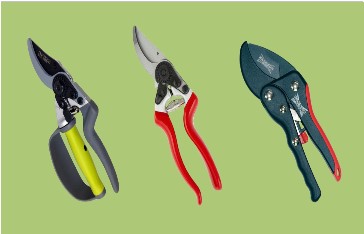3 types of Secateurs or Pruners
The Different Types of Secateurs
When it comes to pruning secateurs, you need not only consider the type of blade material, but also the shapes and mechanism in which the blades move.
The most common types of secateurs are bypass, anvil and parrot beak.
Bypass secateurs are of the most popular on market today. Blades move in a scissor-like action when cutting which offers a very clean cut. These are great for pruning shrubs and general everyday use.
Anvil secateurs offer a far stronger but messier cut. With this variety a sharp blade cuts into an anvil, which provides a lot of power in the cut. These are great dead wood and larger branches.
Parrot Beak Secateurs
This variety of pruning shears is quite similar to the bypass secateurs. However, parrot beak secateurs have concave shaped blades which allow you easier access to trickier cuts.
This is a great option when cutting between narrow stems. The main difference between anvil and bypass blades are how they interact and cut.
Your choice will depend on your gardening needs. Should you need a tool for bigger cuts, choose anvil secateurs. If you need a blade for all-round use, consider a bypass or parrot beak blade.
Features to Look Out for Before Purchasing Secateurs
Whichever material or style you are looking at for your garden shears, you’ll want to look at certain considerations that will ensure the cleanest cuts and tool longevity.
Before you make your purchase consider the following:
- Blades. You’ll want to find sharp blades that can offer clean cuts with minimal physical pressure or exertion.
- Blade Cut Diameter. It’s always a good idea to check your blade cut diameter. Smaller garden shears will have a smaller diameter. Your average blade cut diameter should be between 10 to 30 mm.
- Weight. You obviously will want to consider a lightweight option especially for continual use. More robust, heavy-duty models will be heavier, but you still want them light enough not to strain the hands and arms.
- Replaceable Blades & Springs. This is just a nice aspect to have as it means you are able to keep your garden shears for years and are able to simply replace the blades when they begin to blunt.
- Divots for Fingers. Some handles will have ergonomic divots for your fingers which will improve the comfort of use.
Other fancy feature you may find include:
- Shock Absorbers
- Sap Groove
- Oil Sponge
- Revolving Handle
- Dual Safety Locks
Garden Secateurs Care & Maintenance
Your garden secateurs will last longest when kept sharp, clean and well oiled. Proper maintenance is so important as it will also ensure the effectiveness of your garden shears.
Be sure to clean metal parts of your garden secateurs after use. Cleaning with fine wire wool will help to remove any leftover sap or residue which can clog shear mechanisms.
Consider sharpening your blade every 4 to 6 months. This should be done at an angle to optimize blade sharpness.
Oil your shears regularly to keep mechanisms well lubricated. You can apply a linseed oil to the oil and shaft of your shears.







